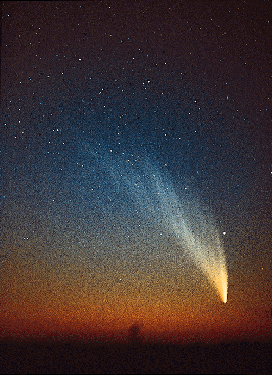 When the comet gets near the Sun, the Sun's heat warms it, causing the ices to sublimate (turn directly from ice into steam), releasing also dust and rock from the nucleus. This creates both the coma (a thin atmosphere) surrounding the nucleus as well as the tail of material that generally streams from the nucleus away from the Sun. The size of the coma is thousands, hundreds of thousands, and sometimes millions of kilometers wide and the tail can reach tens of millions of kilometers long. Once the coma and tail form, they outshine and hide the true nucleus.
When the comet gets near the Sun, the Sun's heat warms it, causing the ices to sublimate (turn directly from ice into steam), releasing also dust and rock from the nucleus. This creates both the coma (a thin atmosphere) surrounding the nucleus as well as the tail of material that generally streams from the nucleus away from the Sun. The size of the coma is thousands, hundreds of thousands, and sometimes millions of kilometers wide and the tail can reach tens of millions of kilometers long. Once the coma and tail form, they outshine and hide the true nucleus. Comets are NOT the same as meteors (or so-called "shooting stars"). Meteors streak through our atmosphere in a second or two and are sometimes much brighter than even a "bright" comet. Comets are NOT in our atmosphere--usually much further away than the Moon--and move very slowly with respect to the background stars from night to night, rising and setting each day just as do the Sun, Moon, planets, and stars.
More Info...